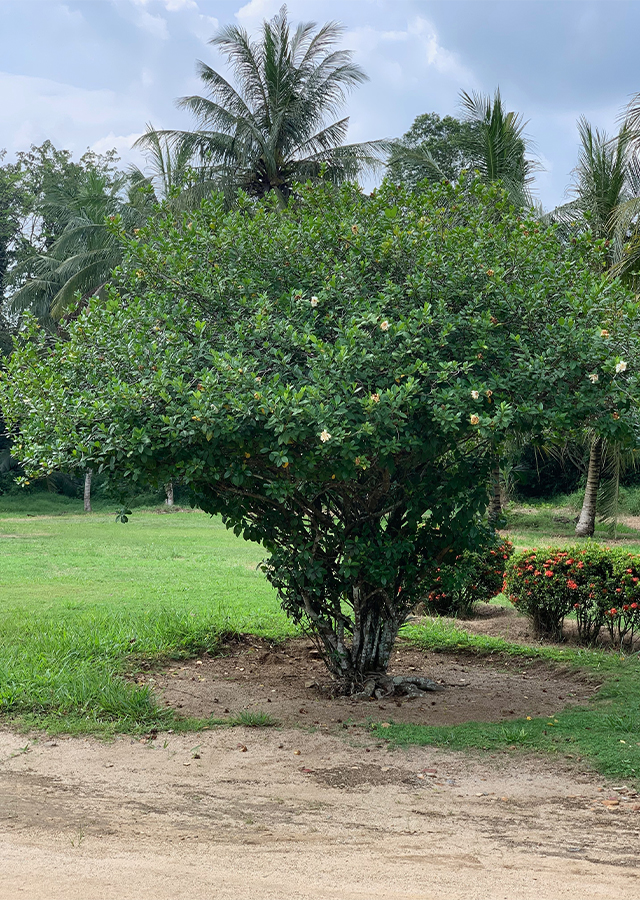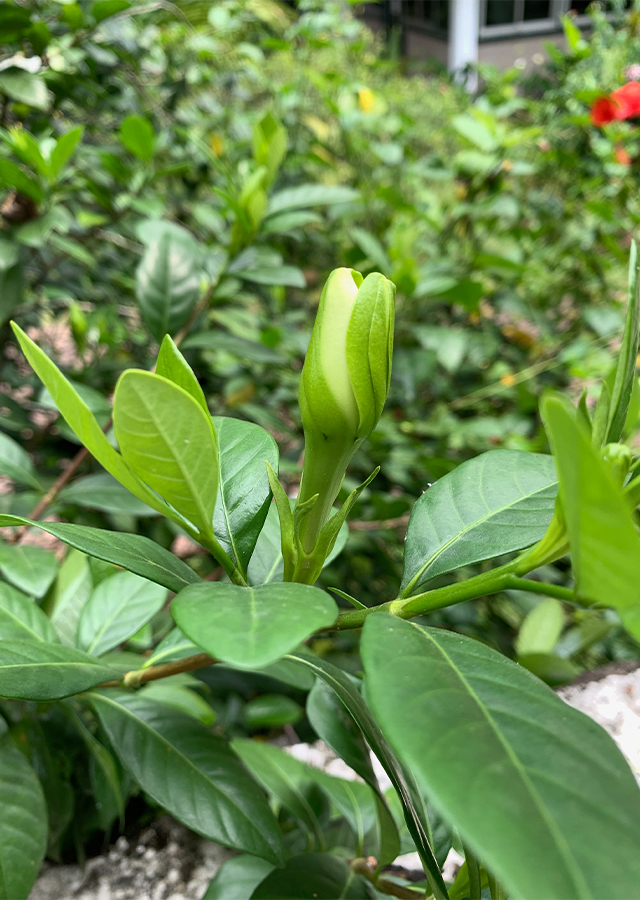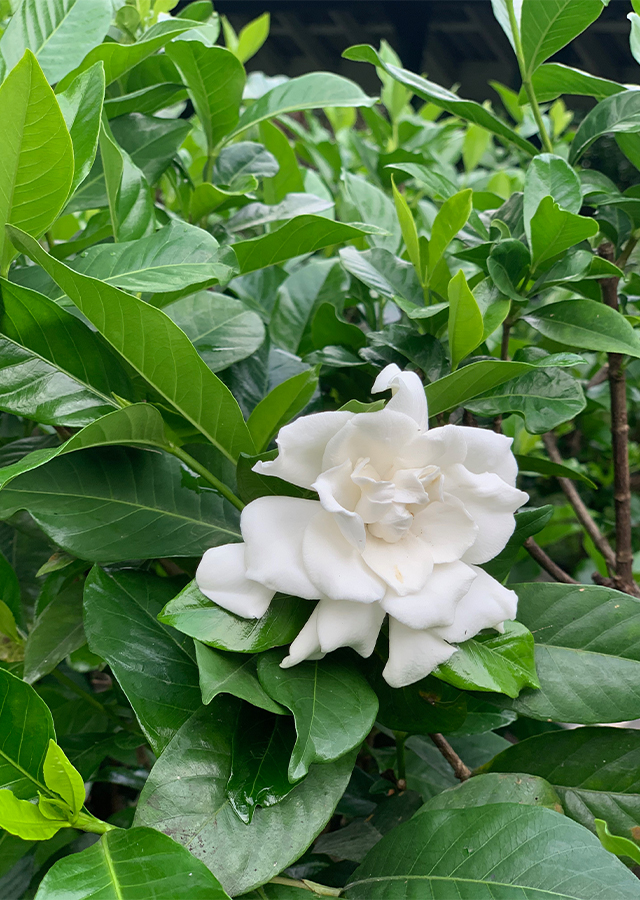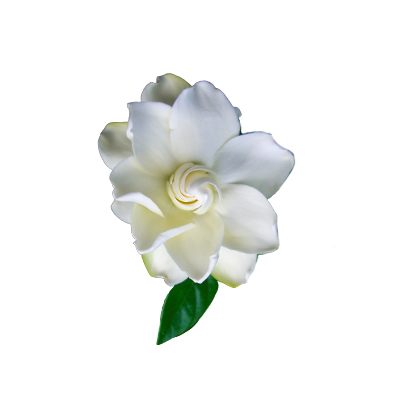Gardenia
Gardenia jasminoides J. Ellis
Rubiaceae
Location in our garden
Principal



Synonym
Jasminum capense Mill.
Gardenia angustifolia G.Lodd.
Gardenia augusta Merr.
Habitus
Shrubs. Gardenia jasminoides is an evergreen shrub or small tree that can grow up to 12 meters tall but is usually much shorter (usually up to 2 m tall)
Part Used
Leaves
Bark
Flowers
Fruit
Roots
Growing Requirements
Full Sunshine
Habitat
Riverbanks
Forest
Mountains
Overview
Gardenia is native to Asia (Southern China, Japan, Ryukyu Islands, and Taiwan). It is widely cultivated in the tropics and subtropics and sometimes naturalized. In South-East Asia it is commonly planted in gardens. The essential oil extracted from the flowers is used in perfumery and cosmetic. preparations. Gardenia fruits also have been used as a yellow dye for staining foods and fabrics. The mild sweet Gardenia blossoms are edible and used dried or fresh to impart fragrance to jasmine tea in the Far East, and are reported beneficial to people with hepatitis.
Vernacular Names
Chin tzu (Chinese), Kaapse jasmijn (Dutch), Gardenie (German), Gandhraj (India), Kuchinashi (Japanese), Buah patah (Malaysia), Rosal (Philippines), kaca piring (Indonesia)
Agroecology
Gardenia is widely cultivated in the tropics and subtropics, originally a species from sub temperate climates. In tropical areas it grows well, at altitudes of 400–1,200 m. It grows best in a mild, humid climate in partial to full sun. Prefers well-drained, fertile, friable soil with a pH of 5–7 and high organic matter. The plant is salt intolerant and somewhat drought tolerant.
Morphology
- Stem - greyish, up to 10 cm in diameter, usually much-branched.
- Leaves - opposite, elliptic– ovate, 3–10 cm long, acuminate or obtuse and cuneate at the base, glossy green, smooth and short petioled, 0.2–0.5 cm long. Stipules large, tubular and obliquely opened on one side.
- Flowers - large and very fragrant, white turning yellowish and solitary at the end of branchlets, pedicels 3–6 mm long with tubular stipule-like bracts, hypanthia turbinate, 6-ridged, 10–12 mm long, sepals 6, obtuse and persistent, corolla salverform, tube 30 mm long, limbs 30–60 mm across deeply 6-lobed.
- Fruits - berrylike, ellipsoid to ovoid, 2.5-4.5 cm long and 1.5-2 cm wide, crowned by persistent calyx with juicy placentae. Initially green turning to yellow to red at maturity.
- Seeds - brown, exudate.
Cultivation
- Seed
- Cuttings of ripe wood, taken with a heel, in a sandy medium
- The plant is usually propagated by cuttings or by marcotting; the best time is soon after flowering, and younger branches should be used. Cattle manure or compost should be applied regularly. Plants may start flowering as soon as one year after planting. Regular pruning after flowering is advisable. Propagated by softwood cutting in spring and hardwood cuttings in summer or from seeds.
Chemical Constituents
Saponins, flavonoids, polyphenol, crocetin, crosin, scandosida, tannins, essential oils, imperatorin, geniposide, iridoid, linalool, syringic acid, vanillic acid, kaempferol.
Traditional Medicinal Uses
Medicinal Uses
- Considered antiophthalmic, emollient, emetic, stimulant, diuretic, antiperiodic, cathartic, anthelmintic, alterative, antispasmodic, external-antiseptic, sedative, analgesic, hypotensive, febrifuge.
- Studies have suggested antioxidant, antidiabetic, antiangiogenic, antifungal, anti-inflammatory, antiproliferative, apoptotic, gastroprotective, anti-hepatofibrotic, anti-thrombotic, antidepressant, antihyperlipidemic, neuroprotective properties.
Traditional Uses
- Decoction of roots used for flatulence, dyspepsia, and nervous disorders due to dentition.
- Decoction of flowers used as wash for inflamed eyes.
- Poultice of leaves for swollen breasts; may be mixed with violeta and other herbs.
- Decoction of bark used for menorrhagia and uterine problems.
- Decoction of bark of stems and branches used for intermittent fevers, dysentery, and abdominal pains. Also used as tonic.
- Resin or paste made from the resin exudate of the fruit is applied to aching teeth, foul sores, and callous ulcers; also, to keep flies from the sores. Internally, used to expel worms. Resin also given for corpulence and to reduce the spleen.
Part Used
Reference Sources
- Fern, Ken. (2014). Useful Tropical Plants. Gardenia jasminoides J.Ellis. http://tropical.theferns.info/viewtropical.php?id=Gardenia+jasminoides 02-02-2021.
- Health & Benefit Times. (No date). Facts and benefits of Cape jasmine. https://www.healthbenefitstimes.com/cape-jasmine/ 02-02-2021.
- Lim, T. K. (2014). Edible Medicinal and Non Medicinal Plants: Vol. 8, Flowers. Springer. DOI 10.1007/978-94-017-8748-2_1. (pp.705-729).
- Sangat-Roemantyo, H. & Wirdateti. Gardenia jasminoides (PROSEA). https://uses.plantnet-project.org/en/Gardenia_jasminoides_(PROSEA) 1-12-2021
- StuartXchange. (2016). Philippines Medicinal Plants. Gardenia jasminoides Ellis. http://www.stuartxchange.com/Rosal.html 02-02-2021.



